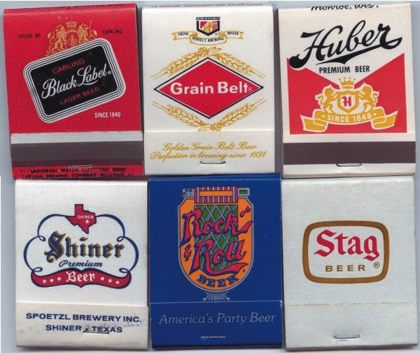Smoking and drinking have been paired together for years. For somebody who does not smoke, I sure have an abundance of ashtrays, cigar cutters, lighters, match safes, matchboxes, matchbooks, and match covers—the tools of tobacco that have been used for years to advertise beer.
Although tobacco has suffered declining sales, many breweries continue to use matches as a form of advertising.

(Kinsley Dey)
The modern history of lighting up began in the early 1800s when a French chemist named Charles Sauria gave us the basic version of the phosphorous fuel applied to the match today. In 1902, Henry C. Traute, a stellar salesman with Diamond Match Co., wrote an order for 10 million matchbooks for the Pabst Brewing Co. of Milwaukee. This first large-scale order gave this beer-marketing tool the impetus it needed.
Interestingly, Traute is also credited with insisting that the match striker be located on the outside of the matchbook. He is the originator of the “Close cover before striking” statement that appears on the foot of the front fold on all match covers. The location of the striker is an important means for dating matchbooks. In the mid-1960s, all strikers had to be placed on the outside of the book and in the mid-1970s, the strikers had to be on the backside.
All About Matches
The manumark is the technical term for the one, two, or three lines of text on a matchbook cover that state something like “Universal Match, Chicago, IL.” The saddle of the matchbook is the flat small fold on the top of the book. The comb is the term for the rows of matches stapled inside. A matchbook collector is known as a phillumenist.
Some of the most sought-after matchbooks by collectors are the ones in which the comb actually had advertising applied to it. The longer, larger, and more colorful books are also more desirable. Many collectors remove the staples and the matches and just display the flattened match covers.
Match safes were capped versions of a matchbox. They were made of brass, silver and gold and were often works of art with embossings, inlays and engravings. Most were about the size of a Zippo lighter and were designed to keep stick matches dry and ready for use. They went out of fashion as matchboxes and matchbooks became commonplace.
Ashtrays and Lighters
Ashtrays have been produced in all formats using non-flammable materials. One of the more interesting ones I have is a collapsible foil version advertising Pabst Blue Ribbon.
The Zippo windproof lighter has been issued advertising many brands of beer. The disposable lighter has also been issued with many forms of beer advertising. One of the newer versions has a bottle opener at one end and the lighter at the other.
When the cigar craze was at its peak in the early 1990s, many brewpubs had a smoking club and many offered their members matchbooks with their logos, wooden matches and elaborate lighters. This craze also led many imported, domestic and craft beer producers to issue cigar cutters with their logos. This was not a new promotional idea, however. Breweries around the turn of the last century issued some very ornate cigar cutters.
Although tobacco has suffered declining sales, many breweries continue to use matches as a form of advertising. Pabst Blue Ribbon showed us that matches are a cheap way to promote your brand; because they are highly collectable, they help to spread the word of your business.











